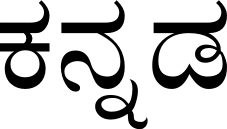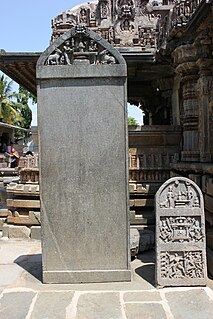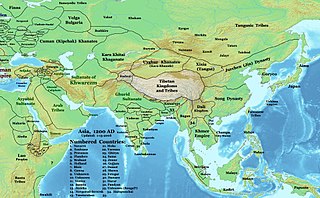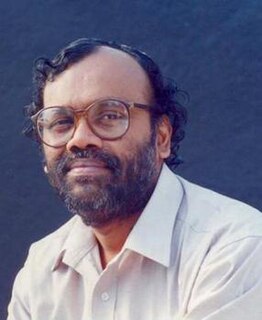Related Research Articles

Kannada is a Dravidian language spoken predominantly by the people of Karnataka in south western region of India. The language is also spoken by linguistic minorities in the states of Maharashtra, Andhra Pradesh, Tamil Nadu, Telangana, Kerala and Goa; and also by Kannadigas abroad. The language had roughly 43 million native speakers by 2011. Kannada is also spoken as a second and third language by over 12.9 million non-Kannada speakers in Karnataka, which adds up to 56.9 million speakers. It is one of the scheduled languages of India and the official and administrative language of the state of Karnataka. Kannada was the court language of some of the most powerful empires of South and Central India, such as the Chalukya dynasty, the Rashtrakuta dynasty, the Vijayanagara Empire and the Hoysala Empire.

Shravanabelagola is a town located near Channarayapatna of Hassan district in the Indian state of Karnataka and is 144 km from Bangalore. The Gommateshwara Bahubali statue at Shravanabelagola is one of the most important tirthas in Jainism, one that reached a peak in architectural and sculptural activity under the patronage of Western Ganga dynasty of Talakad. Chandragupta Maurya is said to have died here in 298 BCE after he became a Jain monk and assumed an ascetic life style.

Kannada literature is the corpus of written forms of the Kannada language, a member of the Dravidian family spoken mainly in the Indian state of Karnataka and written in the Kannada script.

Rashtrakuta was a royal dynasty ruling large parts of the Indian subcontinent between the sixth and 10th centuries. The earliest known Rashtrakuta inscription is a 7th-century copper plate grant detailing their rule from Manapura, a city in Central or West India. Other ruling Rashtrakuta clans from the same period mentioned in inscriptions were the kings of Achalapur and the rulers of Kannauj. Several controversies exist regarding the origin of these early Rashtrakutas, their native homeland and their language.

The Halmidi inscription is the oldest known Kannada language inscription in the Kadamba script. While estimates vary slightly, the inscription is often dated to between 450 CE - 500 CE. The inscription was discovered in 1936 by Dr. M. H. Krishna, the Director of Archaeology of the (princely) State of Mysore, in Halmidi, a village in the Hassan district.
Sri Ponna (c. 945) was a noted Kannada poet in the court of Rashtrakuta Dynasty king Krishna III (r.939–968 CE). The emperor honoured Ponna with the title "emperor among poets" (Kavichakravarthi) for his domination of the Kannada literary circles of the time, and the title "imperial poet of two languages" for his command over Sanskrit as well. Ponna is often considered one among the "three gems of Kannada literature" for ushering it in full panoply. According to the scholar R. Narasimhacharya, Ponna is known to have claimed superiority over all the poets of the time. According to scholars Nilakanta Shastri and E.P. Rice, Ponna belonged to Vengibisaya in Kammanadu, of present day Punganuru, Chittoor District of modern Andhra Pradesh, but later migrated to Manyakheta, the Rashtrakuta capital, after his conversion to the Jainism.

Janna was one of the well-known Kannada poets of the early 13th century who also served in the capacity of a minister and a builder of temples. He graced the court of Hoysala empire King Veera Ballala II and earned the title Kavichakravarthi. His noteworthy writings include Yashodhara Charitre (c.1209) which deals with Jain tenets, Ananthnatha Purana (c.1230) which deals with the teachings of the 14th Jain tirthankara, Anantanatha and a short piece called Anubhava Mukura. Although all his works are known for the grace and style, Yashodhara Charite is his magnum opus and one of the classics of Kannada literature.

Hoysala literature is the large body of literature in the Kannada and Sanskrit languages produced by the Hoysala Empire (1025–1343) in what is now southern India. The empire was established by Nripa Kama II, came into political prominence during the rule of King Vishnuvardhana (1108–1152), and declined gradually after its defeat by the Khalji dynasty invaders in 1311.

A large body of Western Chalukya literature in the Kannada language was produced during the reign of the Western Chalukya Empire in what is now southern India. This dynasty, which ruled most of the western Deccan in South India is sometimes called the Kalyani Chalukya Dynasty after its royal capital at Kalyani and sometimes called the Later Chalukya Dynasty for its theoretical relationship to the 6th-century Chalukya dynasty of Badami. For a brief period (1162–1183), the Kalachuris of Kalyani, a dynasty of kings who had earlier migrated to the Karnataka region from central India and served as vassals for several generations, exploited the growing weakness of their overlords and annexed the Kalyani. Around 1183, the last Chalukya scion, Someshvara IV, overthrew the Kalachuris to regain control of the royal city. But his efforts were in vain, as other prominent Chalukya vassals in the Deccan, the Hoysalas, the Kakatiyas and the Seunas destroyed the remnants of the Chalukya power.
Nāgavarma I (c. 990) was a noted Jain writer and poet in the Kannada language in the late 10th century. His two important works, both of which are extant, are Karnātaka Kādambari, a champu based romance novel and an adaptation of Bana's Sanskrit Kādambari, and Chandōmbudhi, the earliest available work on Kannada prosody which Nāgavarma I claims would command the respect even of poet Kalidasa. According to the scholars K.A. Nilakanta Shastri and R. Narasimhacharya, Nāgavarma I belonged to a migrant Brahmin family originally from Vengi. According to the modern Kannada poet and scholar Govinda Pai, Nāgavarma I lived from 950 CE to 1015 CE. So popular was Nāgavarma I's poetic skills that King Bhoja of Malwa presented him with horses, in appreciation of his poetic skills.
Nagavarma II was a Kannada language scholar and grammarian in the court of the Western Chalukya Empire that ruled from Basavakalyan, in modern Karnataka state, India. He was the earliest among the three most notable and authoritative grammarians of Old-Kannada language. Nagavarma II's reputation stems from his notable contributions to various genres of Kannada literature including prosody, rhetoric, poetics, grammar and vocabulary. According to the scholar R. Narasimhacharya, Nagavarma II is unique in all of ancient Kannada literature, in this aspect. His writings are available and are considered standard authorities for the study of Kannada language and its growth.

Rashtrakuta literature is the body of work created during the rule of the Rastrakutas of Manyakheta, a dynasty that ruled the southern and central parts of the Deccan, India between the 8th and 10th centuries. The period of their rule was an important time in the history of South Indian literature in general and Kannada literature in particular. This era was practically the end of classical Prakrit and Sanskrit writings when a whole wealth of topics were available to be written in Kannada. Some of Kannada's most famous poets graced the courts of the Rashtrakuta kings. Court poets and royalty created eminent works in Kannada and Sanskrit, that spanned such literary forms as prose, poetry, rhetoric, epics and grammar. Famous scholars even wrote on secular subjects such as mathematics. Rashtrakuta inscriptions were also written in expressive and poetic Kannada and Sanskrit, rather than plain documentary prose.
Old Kannada or Halegannada is the Kannada language which transformed from Purvada halegannada or Pre-old Kannada during the reign of the Kadambas of Banavasi.
Extinct Kannada literature is a body of literature of the Kannada language dating from the period preceding the first extant work, Kavirajamarga.
Ratnakaravarni was a 16th-century Kannada poet and writer. He is considered to be one of the trailblazers in the native shatpadi and sangatya metric tradition that was popularised in Kannada literature during the rule of the Vijayanagara empire in modern Karnataka. His most famous writing is the story of the Jain prince Bharata and is called the Bharatesha Vaibhava. Known to be a troubled and restless person, tradition has it that Ratnakaravarni converted from his religion Jainism to Veerashaivism when a less-meritorious poet superseded him. During this brief time, he wrote the Basavapurana, a biography of the 12th century social reformer Basavanna. Later, he returned to the Jain religion and penned classics in the shataka metre. His contributions to Kannada literature are considered trend setting.
Andayya was a notable 13th-century Kannada writer during the rule of the Hoysala empire. Andayya was a Jain by faith and came from a family of accountants. His most important extant work is the Kabbigara Kava which also goes by the names Sobagina Suggi, Madana Vijaya or Kavana Gella and was written in the 1217–1235 CE period.

The Tyagada Brahmadeva Pillar is a decorated free standing pillar, 2.3 m tall, commissioned by Chamundaraya, an important minister and commander in the Western Ganga kingdom, during the rule of King Marasimha II (963–975), Rachamalla IV (975–986) and Rachamalla V. The pillar dates to around 983 C.E. and exists on the Vindyagiri hill in the important Jain heritage town Shravanabelagola, in the Karnataka state, India. On the base of the pillar, on the north side, is an inscription in old Kannada language of the same period, which according to epigraphist and historian B.L. Rice confirms Chamundaraya's involvement in the erection of the pillar. Free standing pillars are a characteristic feature of the Western Ganga art and are broadly classified as "Mahastambha" and "Brahmastambha".

Akkana Basadi is a Jain temple built in 1181 A.D., during the rule of Hoysala empire King Veera Ballala II. The basadi was constructed by the devout Jain lady Achiyakka, wife of Chandramouli, a Brahmin minister in the court of the Hoysala king. The main deity of the temple is the twenty-third Jain Tirthankar Parshwanath. The temple is protected as a monument of national importance by the Archaeological Survey of India.

Dr. D. R. Nagaraj (1954–1998) was an Indian cultural critic, political commentator and an expert on medieval and modern Kannada poetry and Dalit movement who wrote in Kannada and English languages. He won Sahitya Akademi Award for his work Sahitya Kathana. He started out as a Marxist critic but renounced the Marxist framework that he had used in the book Amruta mattu Garuda as too reductionist and became a much more eclectic and complex thinker. He is among the few Indian thinkers to shed new light on Dalit and Bahujan politics. He regarded the Gandhi-Ambedkar debate on the issue of caste system and untouchability as the most important contemporary debate whose outcome would determine the fate of India in the 21st century.
References
- "Inscriptions". Official website of Central Institute for Indian Languages,Government of India. Classicalkannada.org. Archived from the original on 24 June 2013. Retrieved 16 January 2013.
- Nagaraj, D.R (2003). "Critical Tensions in the History of Kannada Literary Culture". In Sheldon Pollock (ed.). Literary Cultures in History: Reconstructions from South Asia. University of California Press, Berkeley & Los Angeles. ISBN 0-520-22821-9.
- Rice, Benjamin Lewis (1889). "Inscriptions on Chandra Giri". Epigraphia Carnatica: Rev. ed, Volume 2-Inscriptions at Shravana Belagola. Bangalore: Government of Mysore Central Press. ID: 3 2044 010 221 265.